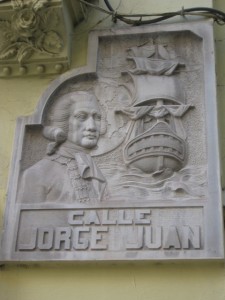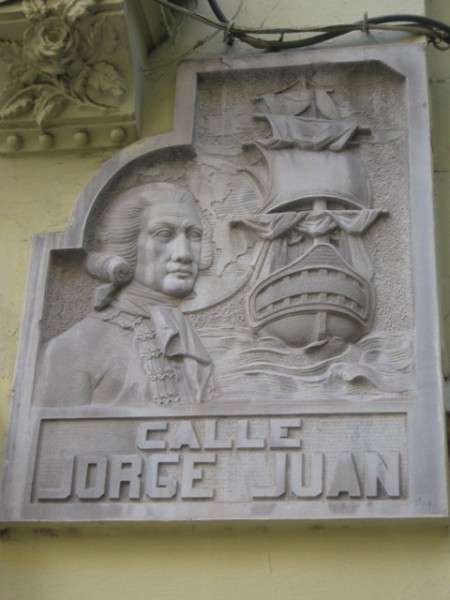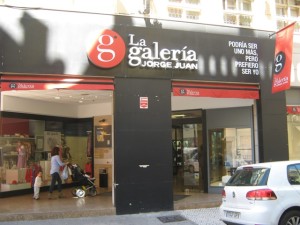Calle Jorge Juan
Even the people who live in them often don’t know the origin of their street names.
 Calle Jorge Juan is a street with many shops, particularly those dedicated to home decoration. It also has a small, indoor shopping centre of the same name. Both street and shopping centre are named after Jorge Juan y Santacilia (January 5, 1713 – June 21, 1773), a Spanish mathematician, scientist and naval officer.
Calle Jorge Juan is a street with many shops, particularly those dedicated to home decoration. It also has a small, indoor shopping centre of the same name. Both street and shopping centre are named after Jorge Juan y Santacilia (January 5, 1713 – June 21, 1773), a Spanish mathematician, scientist and naval officer.
Jorge Juan was born at his parents’ summer home in Novelda, Alicante, although his mother was from nearby Elche. Both of his parents were widowed and on their second marriage when Jorge Juan was born, and they all lived in the Plaza del Mar in Alicante.
His father died when Juan was only three years old and he was educated at the Jesuit school in Alicante, and then by his uncle Cipriano Juan, a Knight of the Order of Malta, who sent him to Zaragoza to further his studies.
At the age of 12 he was sent to Malta to receive Holy Orders at the Order of Malta, later becoming a Knight of the Order, which implied life-long celibacy; perhaps a precocious decision.
In 1729, when he was 16, he returned to Spain and joined the Royal Company of Marine Guards, the Spanish military school for naval officers. He entered the academy in 1730 and studied subjects such as geometry, trigonometry, astronomy, navigation and cartography, finishing his studies there in 1734.
At the age of 22 he was given command of a corvette and participated in campaigns in North Africa.
In 1734, King Philip V sent him and fellow scientist Antonio de Ulloa to join the French Geodesic Mission organized by the French Academy of Sciences. The mission was to measure the length of a degree of the longitudinal meridian at the Equator in South America and to determine the shape of the Earth.
On May 26, 1735 they left Cadiz for South America, where he remained for nine years, occasionally participating in the hostilities against the British Admiral Orson.
The expedition travelled to Ecuador and after nine years of careful study, determined that the Earth is not perfectly spherical but flattened at the poles. They also successfully measured the heights of the mountains of the Andes using a barometer.
He was later ordered to travel in secret to England to study new naval construction methods and armaments. In 1749, travelling under an assumed name, which is the best way to travel in Britain, he learned all that he could, finally bringing British naval constructors back to Spain, avoiding the pursuit of the British authorities in best jaime Bond style.
Many of these Britons would later help build the Spanish ships that would later fight (and lose) at the Battle of Trafalgar.
On his return to Spain in 1750 he was placed in charge of Spanish naval construction and improving the shipyards and armaments, but in 1754 fell from favour due largely to the effectiveness of the British Ambassador Benjamin Keene, who fully understood Jorge Juan’s threat to Britain.
In 1757 he founded the National Astronomical Observatory of Spain, and died in Madrid in 1773 at the age of 60, having also served briefly as Spanish Ambassador to Morocco.


